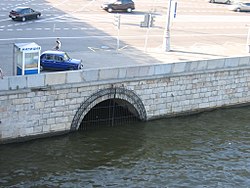Neglinnaya (river)
| Neglinnaya | |
|---|---|
 The Neglinnaya discharges into the Moskva through two tunnels, of which this is one. | |
| Native name | Неглинная (Russian) |
| Location | |
| Country | Russia |
| Physical characteristics | |
| Mouth | Moskva |
• coordinates | 55°44′59″N 37°37′35″E / 55.74972°N 37.62639°E |
| Length | 7.5 km (4.7 mi) |
| Basin features | |
| Progression | Moskva→ Oka→ Volga→ Caspian Sea |
The Neglinnaya (Russian: Неглинная, IPA: [nʲɪˈɡlʲinːəjə]), also known as Neglinka, Neglinna, Neglimna (Неглинка, Неглинна, Неглимна), is a 7.5 km underground river in the central part of Moscow and a tributary of the river Moskva. It flows in the tunnels under Samotechnaya Street, Tsvetnoy Boulevard, Neglinnaya Street and Alexander Garden and Zaryadye. The Neglinnaya discharges into the Moskva through two separate tunnels near Bolshoy Kamenny Bridge and Bolshoy Moskvoretsky Bridge.
History
The river in its natural state used to flow openly from the northern parts of
Muscovites constructed a number of
The first plans to rebuild the Neglinnaya River, presented in 1775, materialized in 1792. A new
The first reconstruction (1910—1914) replaced part of the tunnel with a larger pipe, but was terminated by
In 1966, the city built a second arm for the Neglinnaya River (length: 1 km,
Present-day ponds on Manezhnaya Square (1996) are not the Neglinnaya River but an imitation. The real river runs too deep to be properly displayed. The area is dotted with diminutive statues on subjects taken from Russian fables designed by Zurab Tsereteli.
Gallery
-
"Truba" ("Tube") in wall of Bely Gorod. By Apollinary Vasnetsov
-
Kuznetsky Bridge. By Apollinary Vasnetsov
-
Voskresensky Bridge. By Apollinary Vasnetsov. Away see Troitsky Bridge
-
Mouth of Neglinnaya. By Apollinary Vasnetsov
-
Neglinnaya River approximately under the Animal Theatre
-
Numerous small connecting pipes to the underground river
-
Connecting tunnels
-
Modern section of the tunnel
-
Modern section connecting a historical length of the tunnel
-
Historical length of the tunnel
-
Junction of tunnels
-
Surface exit
External links
- (in Russian) Contractors report with photographs of the 1965 flood www.mosinzhproekt.ru












